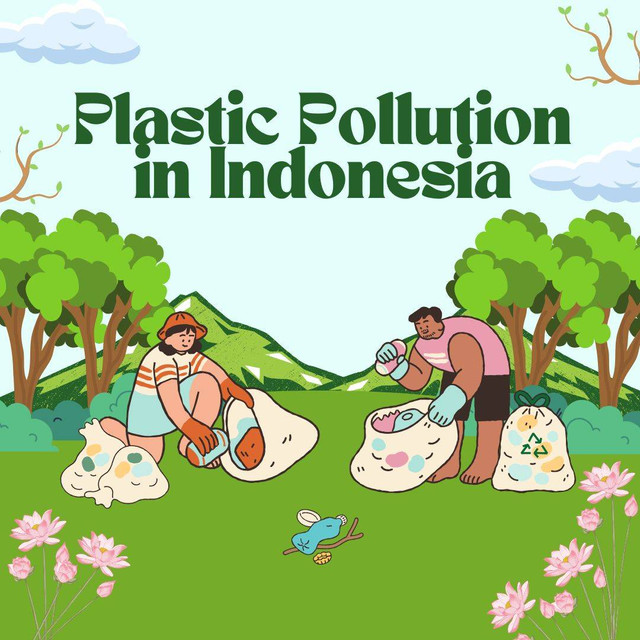Tentang KamiPedoman Media SiberKetentuan & Kebijakan PrivasiPanduan KomunitasPeringkat PenulisCara Menulis di kumparanInformasi Kerja SamaBantuanIklanKarir
2025 © PT Dynamo Media Network
Version 1.103.0
Konten dari Pengguna
Plastic Pollution in Indonesia
13 Desember 2024 15:25 WIB
·
waktu baca 4 menitTulisan dari Zahra Fazreen tidak mewakili pandangan dari redaksi kumparan

ADVERTISEMENT
Introduction
Plastic pollution is an environmental issue that is caused by the accumulation of indispensable plastic products. This essay will highlight the ongoing global crisis of plastic pollution in Indonesia, primarily caused by the plastic waste sent to landfills and the excessive use of plastic, which poses a threat towards the marine life. To tackle the adverse effects on wild life in Indonesia, two approaches are recommended: reduce single use plastic and embrace plastic alternatives. Through comparing and contrasting, it is clear to see that fusing both solutions is the best and most conducive way to settle the issues of water pollution in the Indonesia.
ADVERTISEMENT
Situation
That being the case, the main cause of plastic pollution in Indonesia is caused by the plastic waste sent to landfills. This is because plastic products are favoured for their affordability and unmatched convenience, making them the top choice for governments, businesses and consumers when it comes to disposing of their plastic waste. In 2023, Indonesia was described as a nation overwhelmed by plastic pollution. This is all due to the fact that Indonesia generates over 7.8 million metric tons of plastic annually, coupled with a lack of public awareness. Additionally, poor waste management exacerbates the problem. This is because Indonesia’s waste management infrastructure is inadequate, and the widespread use of single-use plastics significantly contributes to the crisis, with an estimated 8 million tons of plastic ending up in the ocean annually.
ADVERTISEMENT
Problem
Firstly, one significant impact of plastic pollution in Indonesia is the effect on marine wildlife. Numerous reports highlight the distressing trend where marine creatures such as: sea turtles, dolphins and various fish species have been discovered dead due to the entanglement or ingestion of plastic debris. One of the problems that plastic pollution causes towards marine wildlife is the reduction in their population. Plastic pollution reduces marine wildlife populations as animals mistake plastic waste for food, leading to digestive blockages, malnutrition and death. Furthermore, abandoned fishing gears and nets can entangle these creatures leading to suffocation.
A second issue caused by plastic pollution is the contamination of oceanic habitat. This is because plastic waste discarded in landfills can leak into ocean. These plastic debris can release plastic toxins, such as: BPA and PAHs which are absorbed by marine animals. These harmful substances can wreak havoc in marine organisms altering natural processes within their body. Therefore, it is clear that plastic pollution in Indonesia is one of the contributing factors to the decline in marine animal populations and is the leading cause towards water pollution.
ADVERTISEMENT
Solution
Now, a key solution to combat plastic pollution in Indonesia is to reduce the use of single-use plastics such as, utensils and plastic bottles. This is crucial because plastic products are non-biodegradable eventually breaking down into harmful microplastics that threaten wildlife. One effective strategy is adopting a 3R’s lifestyle, which includes – Reducing, Reusing and Recycling. Reducing plastic usage decreases greenhouse gas emissions during production. Reusing items fosters conservation of resources and the reduction of waste, while recycling promotes a circular economy where materials are reused in order to make new products, minimizing plastic waste.
Another effective measure is embracing plastic alternatives like stainless-steel containers, bamboo utensils, or either silicone. These options have long term sustainability and are eco-friendly. Not only does this contribute to a healthier environment, but they also yield long-term saving cost for Indonesia citizens. Therefore, by combining the approach of the 3R’s lifestyle and by using plastic alternatives, Indonesia can mitigate the spread of plastic pollution and move towards a more sustainable, balanced relationship with the environment and the wildlife
ADVERTISEMENT
Evaluation
The reduction of single-use plastics present both opportunities and challenges. This is because, although they can aid in reducing plastic waste, it also intersects with economic growth. One significant benefit is the creation of a cleaner environment for the marine life. By adopting a 3R’s lifestyle and by using plastic alternatives, it can help curtail the encroachment of plastic pollution in rivers and oceans – Reducing the levels of greenhouse gasses, waste management, promotion of resource efficiency and increased renewable energy.
However, some business may resist transitioning to eco-friendly alternatives. These expenses can impact revenues, as adopting green practices often requires time and financial investments. Additionally, eco friendlier options may not be affordable for all citizens, potentially widening economic disparities. Therefore, while reducing single use plastic has many advantages, it also raises economic disparities.
ADVERTISEMENT
Conclusion
As a result, addressing plastic pollution in Indonesia requires a balanced approach that combines reducing single use plastic, promoting the 3R’s lifestyle and adopting sustainable alternatives. Although challenges such as cost and accessibility exist, collaborative efforts from citizens, businesses and governments can effectively combat plastic pollution in oceans and rivers and build a sustainable future for Indonesia and its wildlife.

